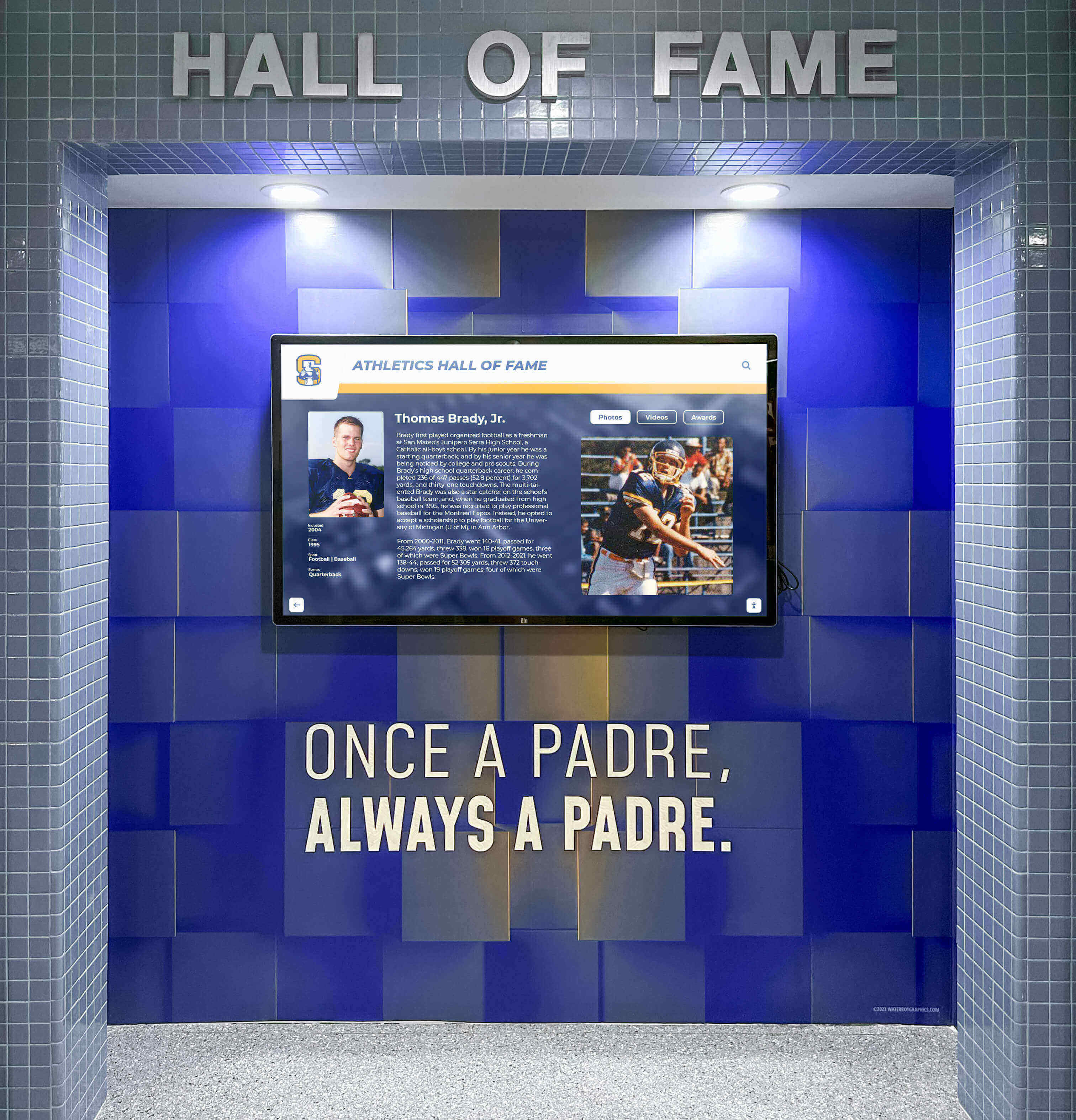Key Takeaways
Discover how modern digital recognition displays transform how the NFL Hall of Fame and football programs honor legends. Explore interactive touchscreen solutions perfect for showcasing football's greatest achievements, from Canton to youth leagues.
The NFL Hall of Fame: Football’s Ultimate Recognition Institution
Located in Canton, Ohio—the birthplace of professional football where the American Professional Football Association (which became the NFL) was founded in 1920—the Pro Football Hall of Fame serves as football’s premier recognition institution, preserving history and honoring those whose exceptional contributions shaped the game across more than a century.
History and Significance of the Pro Football Hall of Fame
The Pro Football Hall of Fame opened its doors in 1963, establishing a permanent home for celebrating football excellence. The current museum facility, which underwent major expansion and renovation completed in 2017, features more than 83,000 square feet of gallery space, houses artifacts from over 370 members, and welcomes approximately 200,000 visitors annually who come to honor the sport’s heritage and greatest contributors.
According to the Pro Football Hall of Fame’s visitor information, the facility offers immersive experiences including the Hall of Fame Gallery with touch-screen kiosks featuring bios, photos, and videos on each Hall of Famer, the Lamar Hunt Super Bowl Gallery using artifacts and interactive kiosks to tell the Super Bowl’s story, and a visually dynamic two-level exhibit area featuring high-tech interactives and one-of-a-kind artifacts that preserve football’s history.
The museum’s commitment to interactive technology demonstrates recognition that modern audiences expect engaging, multimedia experiences rather than passive observation of static displays. This philosophy aligns perfectly with how organizations at all levels—from professional leagues to youth programs—increasingly embrace digital solutions that transform recognition from simple lists into compelling storytelling platforms.
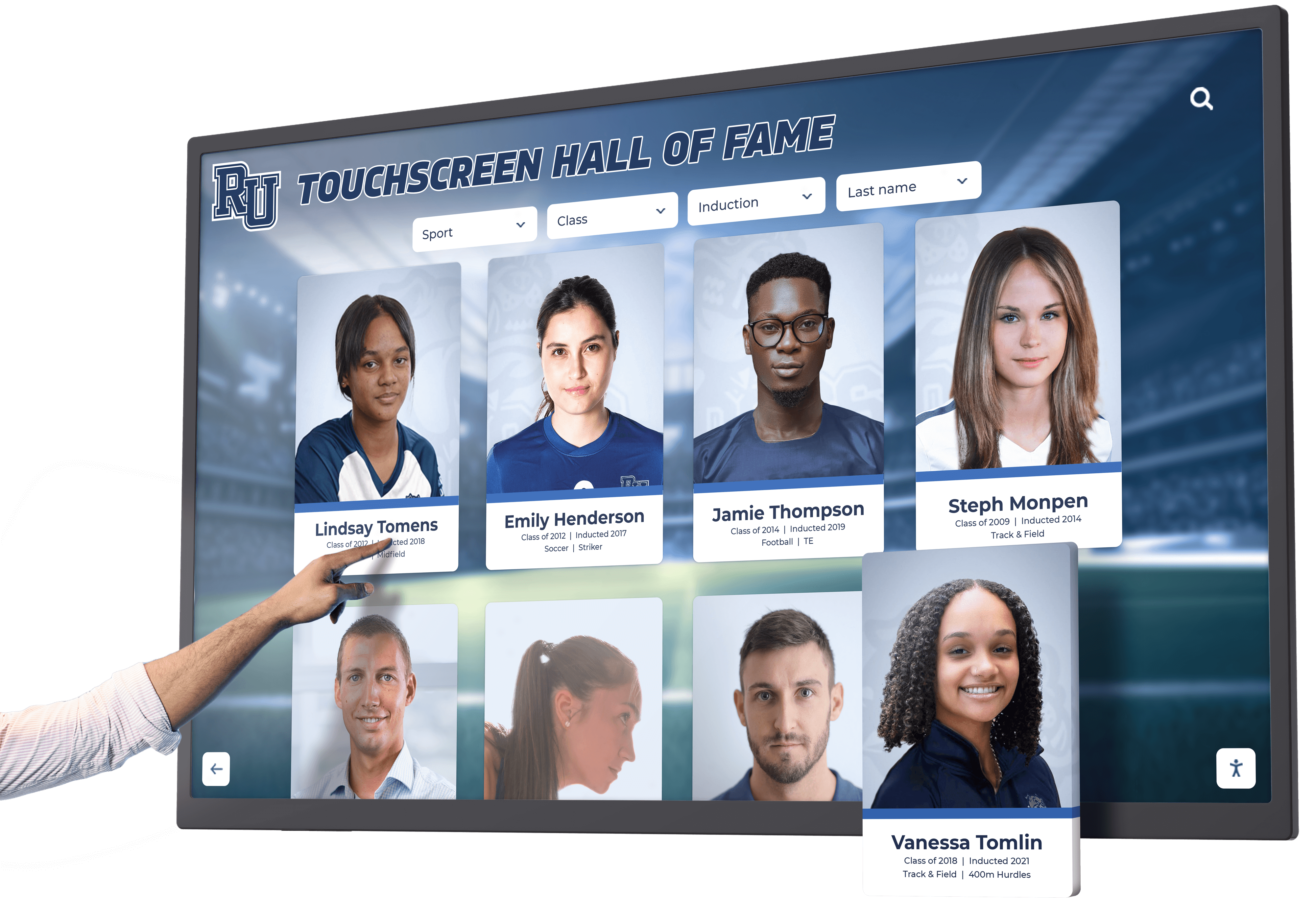
The Enshrinement Process: Honoring Football’s Elite
The Pro Football Hall of Fame’s rigorous selection process ensures that only those who achieved exceptional distinction earn enshrinement. The selection process involves multiple stages, according to the Hall’s official procedures:
Nomination and Screening: Any fan can nominate a former player, coach, or contributor through the Hall’s website. A 50-person Selection Committee comprised of media members representing each NFL city, plus the President of the Pro Football Writers of America, reviews nominations. Nominees must have been retired from professional football for at least five seasons.
Finalists Selection: The Selection Committee meets during Super Bowl weekend to review nominees and reduce the candidate pool to 15 modern-era finalists, plus additional finalists from contributor and senior categories. Discussion focuses on each candidate’s performance, football character, integrity, and sportsmanship—qualities the Hall values beyond statistics alone.
Final Vote: Each Selection Committee member may vote for up to five modern-era finalists. Candidates receiving at least 80 percent of the vote (40 of 50 committee members) earn enshrinement. Between four and eight new members typically join the Hall each year through this selective process.
This careful evaluation process maintains the prestige and integrity that make Hall of Fame recognition meaningful—principles equally important whether selecting NFL legends or recognizing excellence in high school athletic programs.
Why Digital Recognition Displays Excel at Celebrating Football Legends
The Pro Football Hall of Fame’s extensive use of interactive touchscreens and multimedia displays demonstrates why digital recognition technology has become essential for effectively honoring athletic achievement in the modern era.
Unlimited Capacity for Comprehensive Recognition
Physical trophy cases and plaque walls face inevitable space constraints that force difficult decisions about which achievements deserve recognition and which must be omitted or relegated to storage. The NFL Hall of Fame, with over 370 enshrined members and growing annually, would require impossibly large physical spaces to adequately honor each legend with traditional displays.
Digital recognition displays solve this fundamental limitation. A single interactive touchscreen can showcase unlimited profiles with comprehensive information about each honoree—from Canton’s hundreds of legends to a high school program’s decades of all-conference athletes. Solutions like Rocket Alumni Solutions provide platforms specifically designed to accommodate growing recognition needs without physical expansion requirements.
This unlimited capacity proves particularly valuable for football programs at all levels. Whether honoring NFL Hall of Famers, college All-Americans, high school 1,000-yard rushers, or youth league champions, digital systems ensure every deserving athlete receives appropriate recognition rather than being excluded due to space constraints.
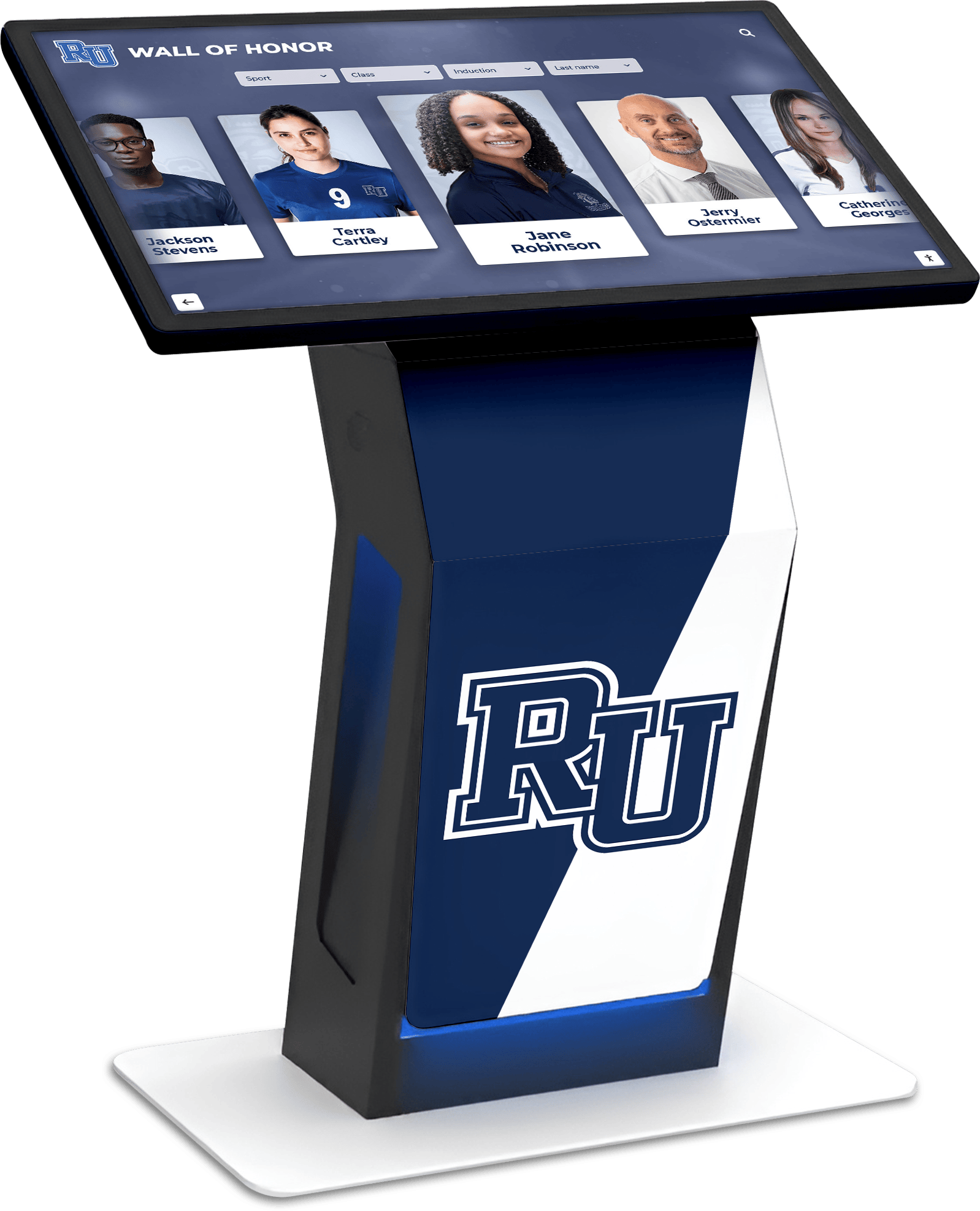
Rich Multimedia Storytelling That Engages Audiences
The Pro Football Hall of Fame’s most memorable exhibits don’t simply list names and statistics—they tell compelling stories through video highlights, audio interviews, and interactive features that bring football history to life. Visitors can watch legendary plays, hear players describe defining moments, and explore careers through comprehensive multimedia timelines.
This multimedia approach creates emotional connections impossible with traditional plaques. When visitors watch video of a game-winning touchdown, hear a quarterback’s Hall of Fame induction speech, or explore an interactive timeline showing a career’s progression, they experience achievement rather than simply reading about it.
Digital recognition platforms enable organizations at every level to create similarly engaging tributes:
- Video highlights: Showcase championship performances, record-breaking plays, and defining moments that capture what made athletes special
- Audio interviews: Include players’ own voices discussing their experiences, coaches describing impact, and teammates sharing memories
- Photo galleries: Display action shots, team photos, celebration images, and career progression across multiple seasons
- Statistical visualizations: Present career statistics, season-by-season progression, and record comparisons through engaging graphics
- Written narratives: Combine biographical information with storytelling that reveals character, work ethic, and impact beyond statistics
Programs implementing digital hall of fame displays report that multimedia content generates significantly more engagement than traditional static recognition, with visitors spending more time exploring profiles and forming stronger emotional connections to honored athletes.
Interactive Exploration and Powerful Search Capabilities
Traditional display boards require visitors to scan through alphabetical lists or physically walk along walls to find specific individuals. The Pro Football Hall of Fame’s touchscreen kiosks provide powerful search and filtering tools allowing visitors to instantly locate players by name, position, team, or era—dramatically improving the discovery experience.
This interactive functionality proves equally valuable for football programs at all levels:
- Position filtering: Quickly find all quarterbacks, running backs, or defensive players
- Team searches: Discover all athletes who played for specific teams across decades
- Achievement categories: Filter by All-Americans, 1,000-yard rushers, championship team members, or other distinctions
- Decade browsing: Explore athletes from particular eras to understand program evolution
- Statistical sorting: Identify career leaders in touchdowns, yards, tackles, or other categories
These search capabilities ensure that recognition remains discoverable and accessible rather than being buried in overwhelming lists. A grandmother visiting from across the country can instantly locate her grandson’s football achievements. Alumni attending reunions can quickly find former teammates. Recruits on campus tours can explore position-specific examples of program excellence.
Interactive hall of fame systems transform recognition from passive tribute into engaging exploration that invites discovery and extends the time visitors spend connecting with program history.
How Rocket Alumni Solutions Perfectly Fits Football Recognition Needs
Just as the Pro Football Hall of Fame relies on digital technology to honor football’s greatest legends effectively, organizations at every level discover that purpose-built recognition platforms provide the best solutions for celebrating athletic achievement.
Purpose-Built Platform for Athletic Recognition
Generic digital signage systems adapted for recognition purposes lack features specifically designed for sports halls of fame. Rocket Alumni Solutions provides a platform purpose-built for athletic recognition with features addressing unique football program needs:
Sport-Appropriate Organization: Content structures designed specifically for football recognition including position groupings, team rosters by season, championship team displays, and individual achievement categories familiar to football audiences.
Statistical Integration: Built-in templates for presenting football statistics in standard formats coaches, players, and fans expect—rushing yards, passing completions, tackles, championships won, and career achievements displayed consistently across profiles.
Multi-Level Recognition: Support for tiered recognition programs that honor various achievement levels—from all-time greats receiving comprehensive multimedia tributes to solid contributors earning professional standard recognition to every participant receiving basic acknowledgment.
Recruiting Focus: Features specifically valuable for recruitment including position-specific filtering, development pathway showcases, academic achievement highlights, and post-graduation success stories that demonstrate program value to prospective athletes and families.
This purpose-built approach contrasts with generic solutions requiring extensive customization to address football recognition needs adequately. Organizations implementing Rocket Alumni Solutions avoid the frustrations of adapting inappropriate platforms while benefiting from features developed specifically for athletic recognition contexts.
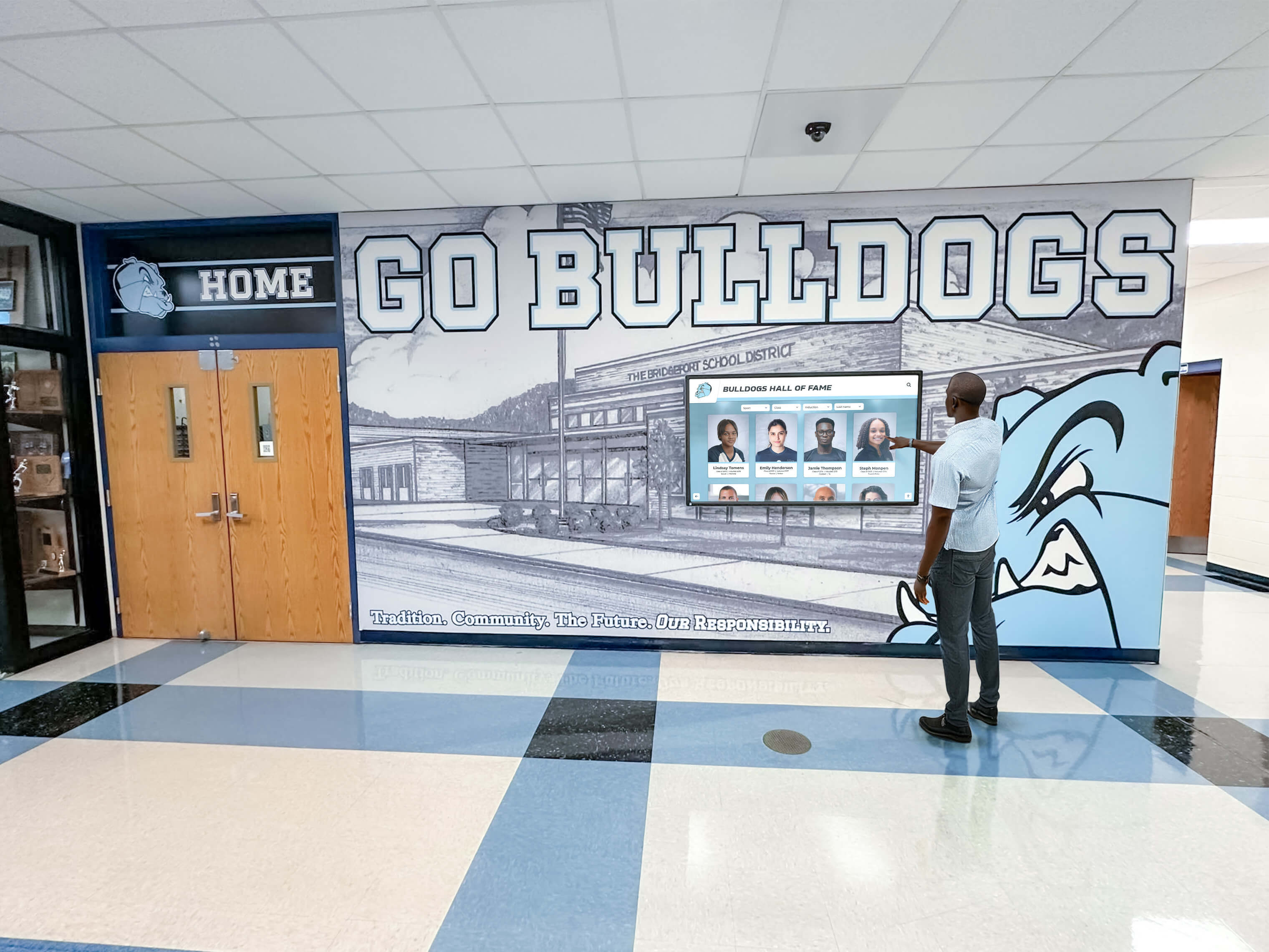
Intuitive Content Management for Non-Technical Staff
The Pro Football Hall of Fame employs dedicated IT and exhibit professionals to manage their sophisticated display systems. Most football programs—particularly high schools, youth leagues, and smaller colleges—lack similar technical resources. Recognition systems requiring coding knowledge, complex software, or technical expertise create unsustainable maintenance burdens.
Rocket Alumni Solutions provides intuitive content management that empowers coaches, athletic directors, and administrators to update recognition displays confidently without technical backgrounds:
Simple Profile Creation: Step-by-step workflows guide users through creating athlete profiles with prompts for essential information, upload interfaces for photos and videos, statistical entry fields with appropriate categories, and preview capabilities before publication.
Template-Based Design: Professional design templates ensure polished, consistent presentation automatically while allowing customization of colors, logos, and branding elements to match institutional identity without requiring graphic design expertise.
Bulk Upload Capabilities: Import rosters, statistics, and historical data efficiently through spreadsheet uploads rather than entering hundreds of individual profiles manually—particularly valuable for establishing comprehensive historical recognition.
Cloud-Based Access: Update content from any internet-connected device—office computers, home laptops, or mobile devices—providing flexibility for busy coaches and administrators managing recognition alongside numerous other responsibilities.
Responsive Support: Access to knowledgeable support staff who understand athletic programs and provide assistance when needed rather than generic technical support unfamiliar with sports recognition contexts.
This focus on usability ensures that recognition systems remain current and effective rather than becoming outdated because updating requires technical skills unavailable within organizations. Resources on content management for digital recognition displays provide additional guidance for establishing sustainable update workflows.
Cost-Effective Long-Term Value
Initial investment comparisons between traditional physical displays and digital systems sometimes favor conventional plaques. However, comprehensive cost analysis reveals digital solutions typically deliver superior long-term value—particularly for growing programs adding new honorees annually.
Traditional Physical Display Costs:
- Custom plaques: $150-400 per inductee
- Professional installation: $75-150 per plaque
- Display boards or infrastructure: $3,000-15,000 depending on scope
- Annual additions: $225-550 per new inductee
- Eventual space exhaustion requiring additional physical displays or removal of older recognition
- Replacement costs when designs become dated or physical condition deteriorates
Digital Recognition System Investment:
- Commercial-grade touchscreen hardware: $5,000-15,000 for comprehensive installations
- Rocket Alumni Solutions platform: $2,000-5,000 annually depending on features and capacity
- Professional installation: $1,000-3,000 for mounting and configuration
- Initial content development: Variable depending on historical depth
- Ongoing additions: Content updates only (no per-inductee material costs)
- No space exhaustion—unlimited capacity for growth
- Software updates maintain contemporary appearance and functionality
Most programs implementing digital recognition achieve cost neutrality within 3-7 years compared to ongoing traditional display expenses while gaining dramatically superior capabilities including unlimited capacity, easy updates, multimedia content, search functionality, and remote accessibility.
Additionally, digital systems eliminate hidden costs associated with traditional displays such as storage for physical awards when display space fills, reinstallation expenses when facilities renovate, and premature obsolescence when recognition styles become dated or damaged, making comprehensive cost comparison strongly favor digital approaches for programs with ongoing recognition needs.
Implementing Football Recognition Programs Across All Levels
The Pro Football Hall of Fame demonstrates principles applicable to football recognition at every competitive level—from professional leagues to youth programs—with digital technology making sophisticated recognition accessible to organizations of all sizes.
High School Football Hall of Fame Programs
High school football programs with strong traditions often accumulate decades of achievement deserving systematic recognition. Digital solutions make comprehensive high school halls of fame practical and affordable:
Honoring Complete Program History: Recognize all-conference selections, all-state athletes, statistical leaders, championship teams, and coaching legends across decades of program history without space constraints limiting who receives recognition.
Supporting Recruiting Efforts: Create impressive recognition displays that distinguish programs during prospect visits, showcasing development pathways, player success examples, and program traditions that influence commitment decisions.
Engaging Alumni Communities: Strengthen connections with former players who see their achievements honored professionally, creating natural touchpoints for re-engagement, reunion organization, and potential philanthropic support.
Inspiring Current Athletes: Provide visible examples of excellence achieved by those who came before, setting standards and demonstrating what commitment and dedication can accomplish within the program.
Schools implementing college athletics hall of fame recognition approaches at the high school level create sophisticated programs that honor tradition while motivating current student-athletes toward their own excellence.
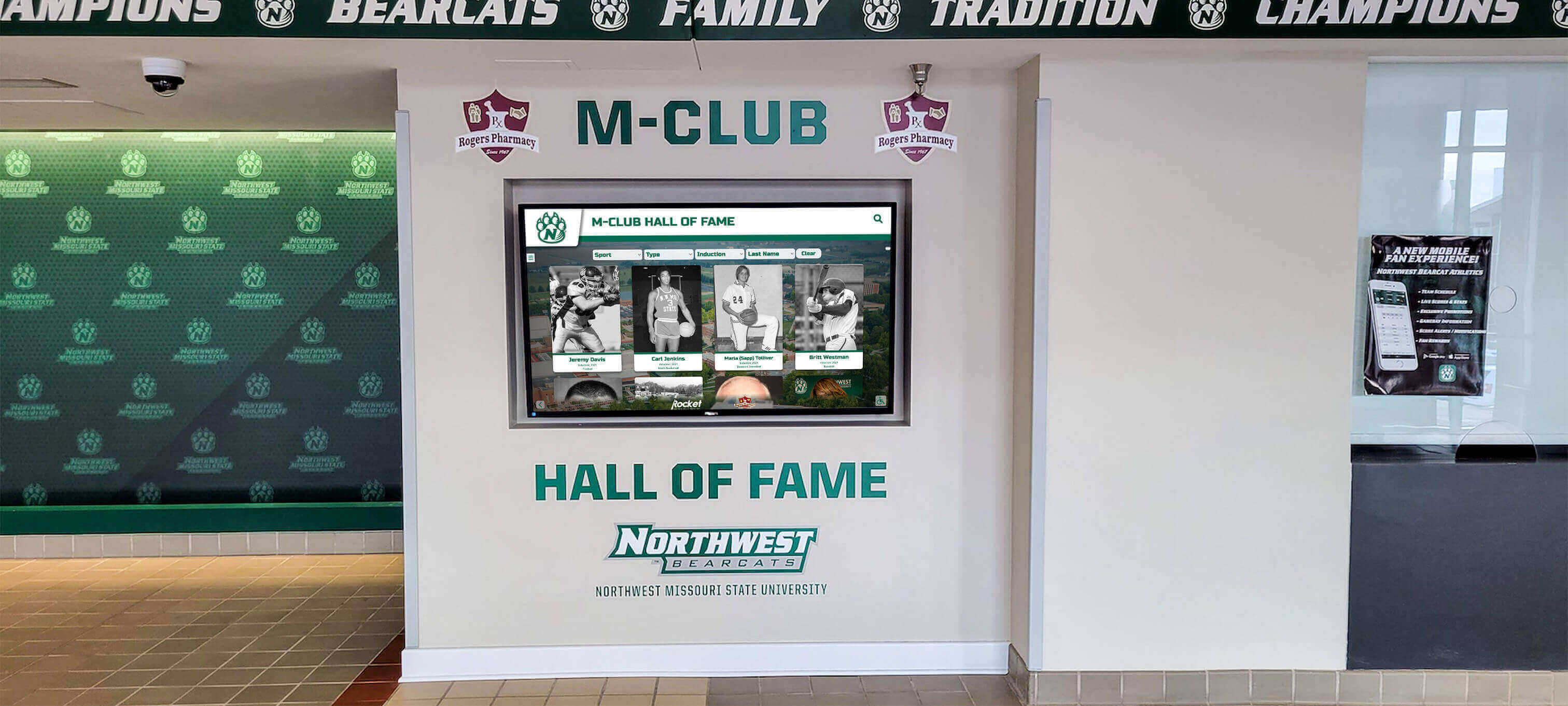
College Football Recognition Programs
College programs ranging from major conference powerhouses to Division III institutions benefit from digital recognition systems that honor football excellence while serving broader institutional missions:
Comprehensive Multi-Sport Recognition: Integrate football hall of fame content within broader athletic walls of honor that celebrate achievement across all sports, demonstrating institutional commitment to comprehensive athletics rather than only revenue-generating programs.
Academic Integration: Highlight Academic All-Americans, graduation rates, and post-football career success alongside athletic achievements, communicating that programs develop complete individuals prepared for life beyond football.
Alumni Engagement Platform: Create recognition displays accessible both on campus and remotely through web interfaces, extending engagement to geographically dispersed alumni worldwide while providing content for alumni communications and fundraising campaigns.
Facility Enhancement: Install displays strategically throughout athletic facilities—stadium club levels, training facility lobbies, recruiting lounge areas—ensuring recognition receives maximum visibility among recruits, fans, donors, and campus community members.
Universities implementing comprehensive recognition discover that investment delivers returns across multiple institutional priorities including enhanced recruiting competitiveness, increased alumni engagement and philanthropic support, strengthened program culture and athlete motivation, and positive media coverage and community goodwill that benefits broader institutional reputation.
Youth and Community Football Programs
Digital recognition technology once accessible only to elite professional and collegiate programs now serves organizations at every level, including youth leagues and community programs:
Age-Appropriate Recognition: Honor participation, sportsmanship, improvement, and team achievements alongside competitive excellence, creating inclusive recognition that celebrates multiple pathways to success at youth levels where development matters more than winning percentages.
Affordable Implementation: Entry-level digital recognition systems starting under $5,000 make sophisticated displays accessible even for programs with modest budgets, particularly when compared to ongoing costs of traditional recognition requiring annual material expenses.
Family Engagement: Provide recognition parents can share with extended family through web access and social media, strengthening program visibility and creating positive word-of-mouth that attracts families when selecting youth sports programs.
Longitudinal Documentation: Build comprehensive historical records documenting program evolution, participant progression, and community impact across years and decades of youth football development.
Community programs implementing digital trophy case solutions create professional recognition experiences that elevate program stature while celebrating achievement and development in age-appropriate frameworks.
Key Features That Make Digital Recognition Perfect for Football
Understanding specific capabilities that make digital displays ideal for football recognition helps organizations evaluate solutions and implement effective programs.
Dynamic Content Updates During Football Season
Unlike traditional plaques requiring fabrication delays, digital systems enable real-time recognition updates throughout seasons. When a running back rushes for 200 yards Friday night, recognition displays can be updated by Saturday morning. When a quarterback breaks the program passing record mid-season, immediate recognition acknowledges achievement when excitement peaks rather than waiting until season’s end.
This real-time capability creates powerful motivational effects where current athletes see their achievements recognized immediately. It also keeps displays perpetually current and relevant—fans and visitors encountering recognition content during season see up-to-date information reflecting latest accomplishments rather than outdated statistics from previous years.
Many programs feature current season prominently through dedicated sections highlighting statistical leaders, notable performances, team standings, and milestone achievements while maintaining complete historical archives accessible through search and navigation features. This combination of immediacy and comprehensiveness proves impossible with traditional static displays.
Championship Team Recognition With Complete Rosters
Individual player recognition dominates many traditional hall of fame displays, with championship teams acknowledged through basic plaques listing years won. Digital platforms enable comprehensive championship recognition that honors every contributor:
Complete Team Rosters: List all players, coaches, and staff who contributed to championships rather than only stars or starters, acknowledging that championships result from entire team efforts.
Season Narratives: Tell complete championship season stories including regular season progression, playoff journeys, defining moments, obstacles overcome, and lasting program impact.
Game-by-Game Results: Document championship paths through comprehensive schedules, scores, statistical highlights, and significant plays that defined seasons.
Multimedia Celebrations: Include championship game video highlights, celebration photos, media coverage, and participant reflections that capture emotional significance beyond statistics.
Multi-Year Dynasty Recognition: For programs winning multiple consecutive championships, create special content recognizing sustained excellence and comparing achievements across different championship teams.
This comprehensive team recognition resonates powerfully with alumni who were role players rather than stars but who understand their contributions mattered. It also communicates to current athletes that programs value everyone’s commitment, strengthening team culture and collective identity. Resources on college football hall of fames provide additional frameworks for championship recognition approaches.
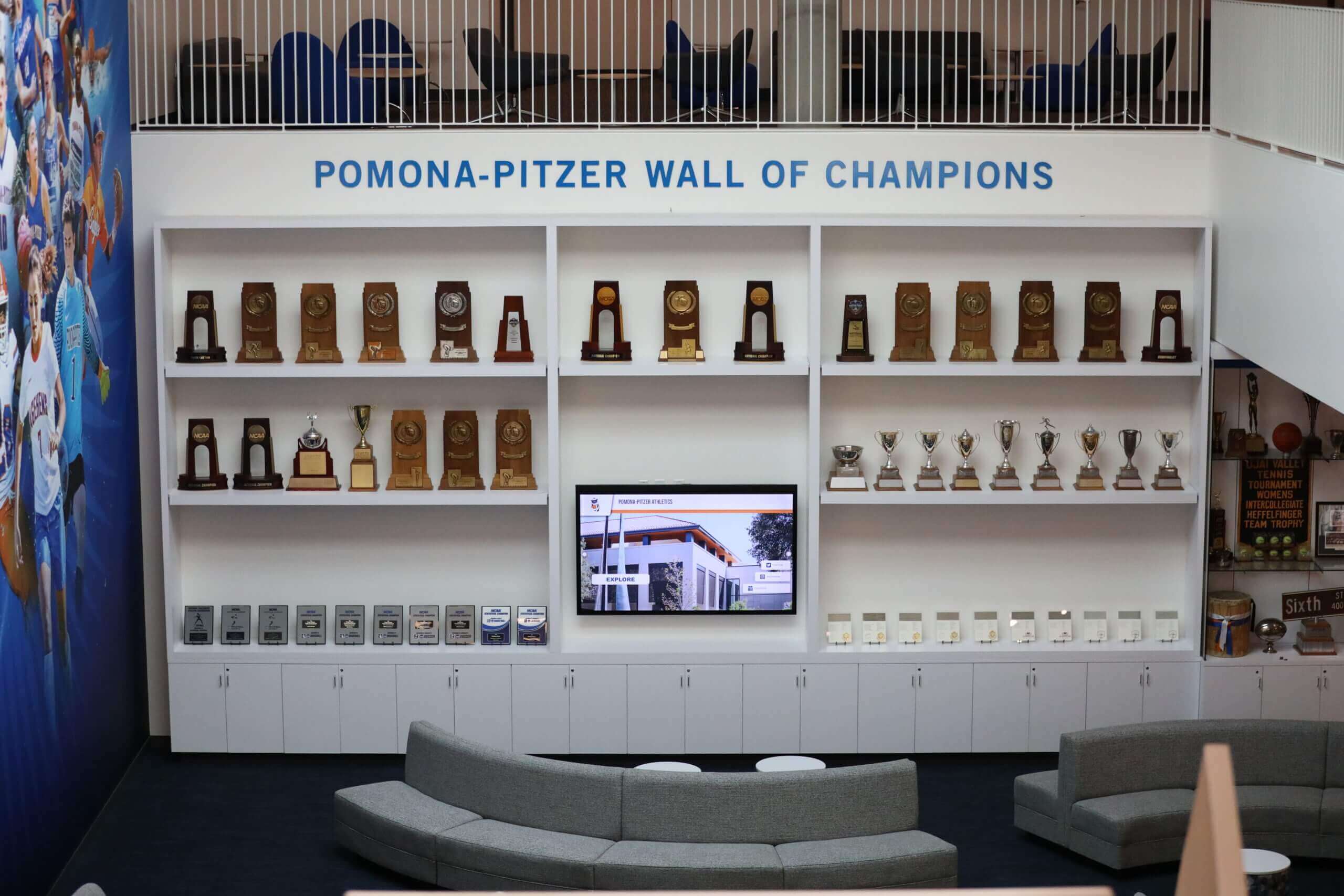
Position-Specific Recognition and Statistical Leaders
Football’s position-specific nature creates unique recognition challenges—comparing a quarterback’s passing yards to a defensive tackle’s tackles makes little sense, yet traditional displays often force such inappropriate comparisons or organize alphabetically regardless of position.
Digital recognition excels at position-appropriate organization:
Position Group Galleries: Create dedicated sections for quarterbacks, running backs, receivers, linemen, linebackers, defensive backs, and specialists where athletes compete for recognition against position-appropriate benchmarks.
Position-Specific Statistics: Display relevant statistics for each position—passing yards for quarterbacks, rushing yards for running backs, tackles for linebackers—rather than forcing inappropriate comparison categories.
All-Time Leaders Boards: Maintain dynamic leaderboards showing top 10 career performers in position-appropriate statistical categories, automatically updating as current athletes climb historical rankings.
Recruiting Showcase Features: Enable position-specific content filtering valuable during recruiting where prospects want to see examples of previous players at their position, understanding development pathways and success possibilities.
Positional Evolution Timelines: Document how positions evolved across eras—showcasing how passing games developed, defensive schemes changed, or specialized roles emerged across program history.
This position-appropriate recognition creates more meaningful acknowledgment while providing valuable functionality for coaches, athletes, and fans exploring program history through relevant frameworks.
Post-Football Success Stories That Demonstrate Program Value
The Pro Football Hall of Fame recognizes that football careers represent one chapter in longer life stories. Similarly, comprehensive recognition programs acknowledge post-football accomplishments that demonstrate program impact beyond athletic fields:
Professional Careers: Highlight NFL players, coaching careers, sports media professionals, and others who continued in football-related fields, demonstrating program development pathways.
Educational Achievements: Recognize advanced degrees earned, academic honors received, and educational career paths that showcase how football programs develop scholars alongside athletes.
Business and Community Leadership: Celebrate entrepreneurial success, corporate leadership roles, community service contributions, and civic engagement that demonstrates character development.
Military Service: Honor veterans who served their country after football careers, acknowledging sacrifice and continued commitment to values learned through athletics.
Family Legacies: Document multi-generational program participation where sons, daughters, or grandchildren continue family football traditions, demonstrating lasting program connections.
This holistic recognition communicates particularly powerfully to recruits and their families evaluating programs. While all programs showcase athletic success, those demonstrating comprehensive development and post-football achievement stand apart as institutions genuinely invested in complete personal growth beyond winning games.
Creating Effective Football Recognition Content
The quality of recognition content determines whether displays inspire and engage or simply list names. Successful programs develop compelling content through systematic approaches.
Writing Engaging Player Profiles
Effective player profiles balance statistical documentation with storytelling that reveals character and impact:
Opening Narrative Hook: Begin profiles with defining moments, memorable plays, or distinctive characteristics that capture what made athletes special rather than starting with basic biographical data.
Career Arc Structure: Organize information chronologically showing progression from recruitment through seasons to senior year achievements, helping readers understand development journeys rather than just final statistics.
Specific Details Over Generic Praise: Include concrete examples—“rushed for 243 yards against rival Lincoln High in 2019 playoff game”—rather than generic statements like “outstanding running back.”
Coach and Teammate Perspectives: Incorporate quotes from coaches describing impact or teammates sharing memories when available, adding authenticity and multiple perspectives beyond statistics.
Character Elements: Highlight leadership qualities, work ethic examples, team-first attitudes, or obstacles overcome that reveal who athletes were beyond statistics and awards.
Post-Football Context: Include current career information, continued program involvement, family details, or other life achievements that demonstrate lasting program impact and continued success.
Well-written profiles transform recognition from data lists into compelling narratives that honor complete individuals while creating emotional connections with readers. Resources on storytelling through digital recognition provide additional content development guidance.
Collecting Historical Content Through Alumni Engagement
Programs establishing comprehensive recognition often face challenges gathering information about athletes from decades past. Successful content development turns this challenge into alumni engagement opportunity:
Structured Outreach Campaigns: Contact former athletes systematically requesting biographical updates, career highlights, favorite memories, advice for current players, and photo submissions for profiles.
Reunion Integration: Coordinate recognition content development with reunion events, conducting video interviews, collecting photos and memorabilia, and gathering stories from multiple teammates about significant seasons.
Social Media Crowdsourcing: Use social media platforms to request information about historical teams and players, leveraging alumni networks to identify contacts, locate photographs, and verify facts.
Student Research Projects: Engage students in historical research as experiential learning—journalism students write profiles, communications students conduct interviews, history students research eras, creating educational opportunities while developing content.
Gradual Historical Build: Prioritize recent decades where information flows easily while steadily expanding historical depth through ongoing research, avoiding paralysis from attempting impossible comprehensive historical development immediately.
This systematic approach transforms content development from overwhelming project into sustained engagement strategy that strengthens alumni connections while building recognition depth progressively.
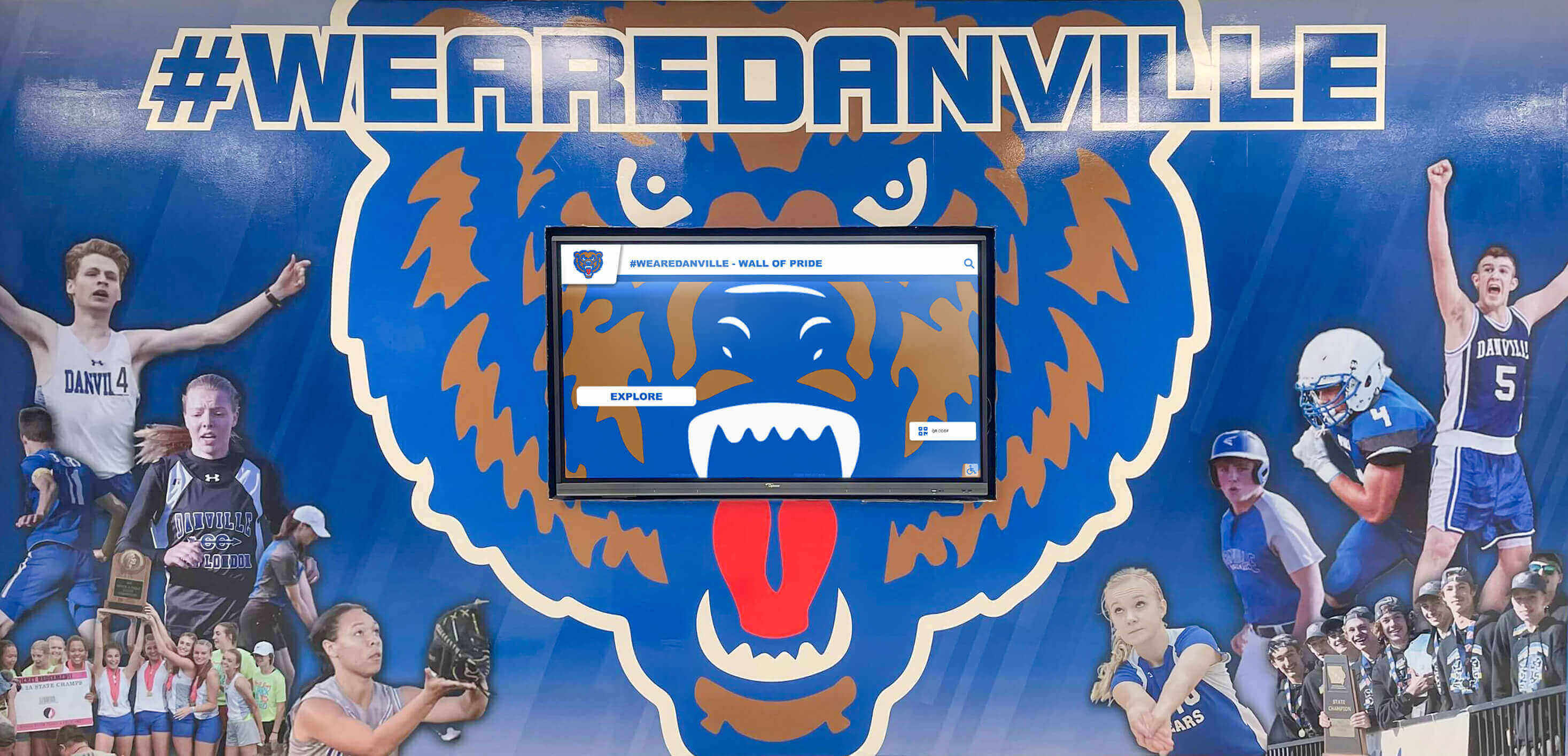
Incorporating Video Highlights and Multimedia Elements
Video content creates the most powerful emotional connections in digital recognition, but programs often struggle with obtaining, processing, and integrating highlight footage effectively:
Sourcing Video Content: Game footage exists in various forms—professional broadcasts for high-profile games, school video systems recording recent seasons, parent recordings from earlier eras, and archived film from historical periods requiring digitization.
Highlight Compilation Approaches: Create concise 30-90 second highlight reels capturing defining plays and moments rather than complete games, maintaining engagement while showcasing achievements efficiently.
Narration and Context: Add brief voice-over or text overlays providing context—what was at stake, what the play accomplished, why it mattered—helping viewers appreciate significance beyond visual footage alone.
Rights and Permissions: Ensure appropriate rights for any broadcast footage used, obtain athlete permissions when required, and document content sources for proper attribution and legal compliance.
Technical Optimization: Process video for efficient streaming—appropriate resolutions, compression, and formats ensuring smooth playback on touchscreen displays and web platforms without excessive bandwidth demands.
Accessibility Considerations: Include closed captions for hearing-impaired visitors and descriptive audio options when possible, ensuring recognition experiences remain accessible to all community members.
Programs implementing multimedia digital hall of fame content report that video highlights generate dramatically more engagement than text and photos alone, with visitors spending significantly more time exploring profiles including video elements.
Measuring Football Recognition Program Success
Evaluating recognition program effectiveness helps justify continued investment while identifying improvement opportunities.
Quantitative Engagement Metrics
Digital recognition platforms provide analytics impossible with traditional displays:
Usage Statistics: Track total interactions, unique visitors, session durations, and peak usage times revealing how frequently and extensively recognition displays are utilized.
Content Performance: Identify most-viewed profiles, popular search terms, and frequently accessed features, informing content development priorities and helping understand what resonates with audiences.
Seasonal Patterns: Analyze engagement variations across seasons—spikes during homecoming, sustained interest during football season, baseline engagement during off-seasons—guiding update timing and promotional emphasis.
Search Behavior: Examine search queries and filtering patterns revealing how visitors discover content, ensuring navigation structures and search functionality serve actual usage patterns.
Geographic Access: For web-accessible recognition, analyze visitor locations demonstrating reach beyond campus to alumni communities nationwide or worldwide.
These quantitative metrics provide objective evidence of recognition value while guiding continuous improvement based on actual usage data rather than assumptions about how visitors engage with content.
Qualitative Feedback and Impact Assessment
Beyond analytics, qualitative assessment reveals recognition program impact on key stakeholder groups:
Alumni Responses: Gather feedback from honored athletes about recognition experience, whether displays strengthen program connections, if content accurately reflects their contributions, and suggestions for improvements.
Current Athlete Perspectives: Survey current players about whether recognition inspires motivation, influences goal-setting, strengthens understanding of program traditions, or provides role models worth emulating.
Recruiting Influence: Solicit feedback from coaches about recognition impact during recruiting, whether prospects and families reference displays positively, if recognition distinguishes program from competitors, and how recognition factors into commitment decisions.
Family and Community Reactions: Collect comments from parents, siblings, extended families, and community members about recognition experiences, social media engagement with recognition content, and whether displays strengthen program support.
Facility Visitor Observations: Monitor how facility visitors interact with displays during tours, events, and casual visits, noting engagement duration, discussion content, and emotional reactions revealing recognition impact.
This qualitative feedback complements quantitative metrics by revealing recognition’s emotional and relational impacts beyond usage statistics alone. Combining both assessment approaches provides comprehensive understanding of program value and effectiveness. Additional frameworks for measuring digital hall of fame success support evaluation planning.
Future Trends in Football Recognition Technology
Emerging technologies continue evolving how organizations honor football excellence and engage audiences.
Enhanced Personalization and Artificial Intelligence
Advanced recognition platforms increasingly incorporate AI-driven features:
Personalized Content Recommendations: Systems analyzing browsing patterns suggest related profiles, similar eras, or connected achievements likely to interest individual visitors based on their interaction history.
Intelligent Search Enhancement: Natural language processing enables conversational search—“Show me all defensive players from the 1990s who earned all-state honors”—rather than requiring structured filtering.
Automated Content Generation: AI assistance in profile creation, suggesting relevant facts from comprehensive data, generating initial narrative drafts for editing, and identifying content gaps requiring additional development.
Predictive Analytics: Machine learning identifying current athletes tracking toward historical records or recognition eligibility, enabling proactive content preparation and timely celebration when milestones are reached.
Augmented and Virtual Reality Integration
Emerging immersive technologies create new recognition possibilities:
AR-Enhanced Physical Spaces: Mobile apps overlaying digital content onto physical facility spaces—pointing a phone at a trophy case reveals video highlights, player profiles, and historical context beyond physical display limitations.
VR Historical Recreation: Virtual reality experiences recreating historic games, allowing visitors to experience championship moments from player perspectives or explore facilities as they appeared in different eras.
360-Degree Game Footage: Immersive video captures allowing visitors to experience plays from various camera angles and perspectives, creating deeper understanding of athletic achievement.
Interactive Stadium Overlays: AR applications enabling visitors to view historical content overlaid onto stadium spaces, seeing how facilities evolved and understanding context of achievements within physical environments.
While these technologies remain emerging, early adopters demonstrate compelling engagement potential that will likely become increasingly accessible to programs at all levels as costs decrease and platforms mature.
Social Integration and Community Participation
Recognition increasingly extends beyond static displays to interactive community platforms:
Social Sharing Integration: One-click sharing of profiles, highlights, and achievements to social media platforms, extending recognition reach beyond physical displays to alumni networks, family circles, and community connections.
Crowdsourced Content Contributions: Platforms enabling alumni and families to submit photos, share memories, and contribute information that enriches official recognition with personal perspectives and previously unavailable content.
Interactive Voting and Ranking: Community engagement features allowing visitors to vote on greatest plays, best teams, or most inspirational athletes, creating ongoing conversation around program history rather than static recognition alone.
Live Commentary and Reactions: Real-time content during current seasons allowing community members to contribute game commentary, react to current achievements, and connect present performance to historical context.
These social features transform recognition from one-directional tribute into participatory community experience that strengthens connections among stakeholders while continuously enriching recognition content through collective contribution.
Conclusion: Honoring Football Excellence Across All Levels
The Pro Football Hall of Fame in Canton, Ohio stands as football’s premier recognition institution, demonstrating through 83,000 square feet of interactive exhibits and touchscreen displays how modern technology transforms recognition from passive tribute into engaging experience. From professional leagues to college programs to high schools to youth organizations, the principles evident in Canton apply universally—comprehensive recognition honors achievement appropriately, multimedia storytelling creates emotional connections, interactive technology enables discovery and exploration, and systematic preservation ensures legacies endure for future generations.
Digital recognition solutions like Rocket Alumni Solutions make sophisticated recognition accessible to football programs at every level. Unlimited capacity ensures every deserving athlete receives appropriate honor, intuitive content management empowers non-technical staff to maintain current displays, cost-effective long-term value makes comprehensive recognition sustainable, and purpose-built features address unique football recognition needs from position-specific organization to statistical integration to championship team celebration.
Whether honoring NFL legends whose achievements shaped professional football history or recognizing high school athletes whose Friday night performances created local legends, modern recognition technology ensures football excellence receives tributes worthy of the dedication, sacrifice, and achievement that define the sport at every level. The interactive touchscreen displays that bring Canton’s Hall of Fame to life can similarly transform how your program celebrates football tradition while inspiring current and future athletes to pursue their own paths to recognized excellence.
Ready to create a football hall of fame worthy of your program’s traditions? Explore how digital recognition solutions transform football recognition from space-constrained displays into comprehensive, engaging celebrations of athletic achievement. Discover more about implementing interactive athletic recognition displays that honor your football legends while inspiring the champions of tomorrow.
Visit Rocket Alumni Solutions to learn how purpose-built recognition platforms perfectly showcase football excellence from professional leagues to youth programs, creating engaging tributes that preserve legacies while motivating current athletes through powerful examples of achievement across football’s rich tradition at every competitive level.
